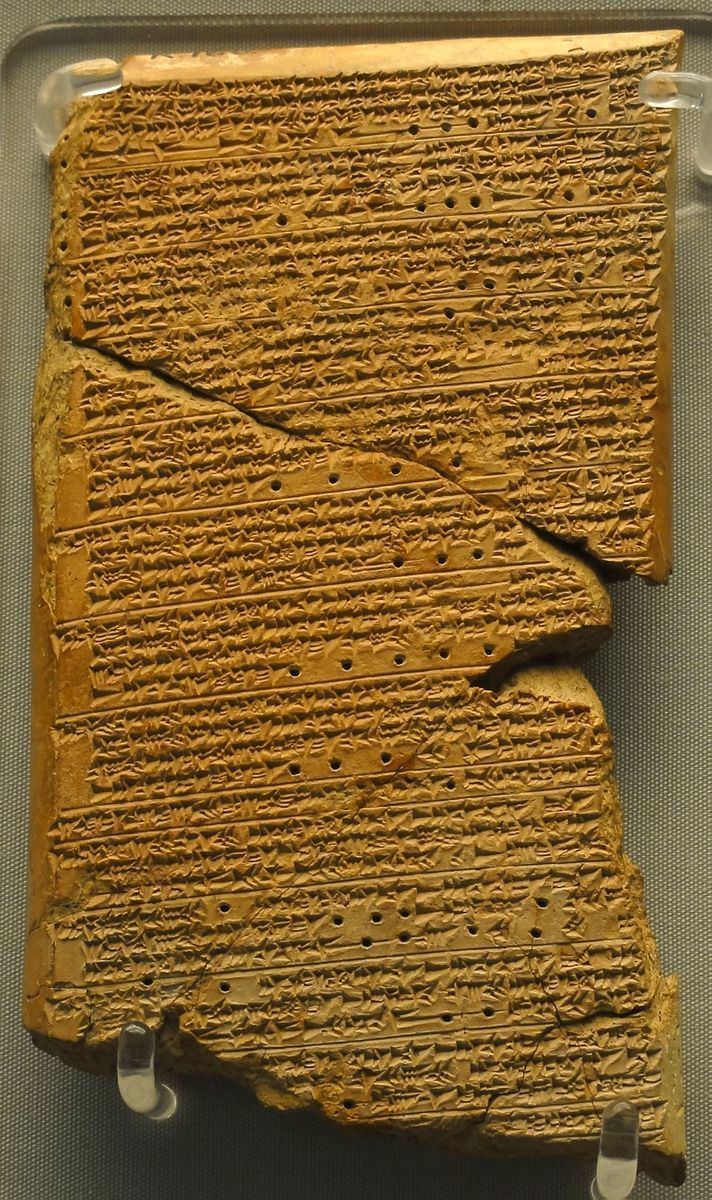Material Clay Period/culture Neo-Assyrian | Writing cuneiform, Place Kouyunjik | |
 | ||
Size Length: 17.14 cm (6.75 in)Width: 9.2 cm (3.6 in)Thickness: 2.22 cm (0.87 in) Present location Room 55, British Museum, London | ||
The Venus tablet of Ammisaduqa (Enuma Anu Enlil Tablet 63) refers to the record of astronomical observations of Venus, as preserved in numerous cuneiform tablets dating from the first millennium B.C. It is believed that this astronomical record was first compiled during the reign of King Ammisaduqa (or Ammizaduga), the fourth ruler after Hammurabi. Thus, the origins of this text should probably be dated to around the mid-seventeenth century B.C. (according to the Middle Chronology).
Contents
The tablet recorded the rise times of Venus and its first and last visibility on the horizon before or after sunrise and sunset (the heliacal risings and settings of Venus) in the form of lunar dates. These observations are recorded for a period of 21 years.
Interpretation
Several dates for the original observations, as contained in the tablet, were proposed early in the 20th century. The following dates, corresponding to the High, Middle, Low and Ultra-Low Chronologies, were inferred for the beginning of the Venus observations: 1702 BC, 1646 BC, 1582 BC, 1550 BC, respectively.
The tablet's significance for corroborating Babylonian chronology was first recognised by Franz Xaver Kugler in 1912, when he could identify the enigmatic "Year of the Golden Throne" ("Venus" tablet K.160) with the 8th year of the reign of Ammisaduqa. Since then, this 7th-century BC copy has been variously interpreted to support several chronologies in the 2nd millennium BC.
Many uncertainties remain about the interpretation of the record of astronomical observations of Venus, as preserved in these surviving tablets. Some copying corruptions are probable. Problems of atmospheric refraction were addressed by Vahe Gurzadyan in a 2003 publication.
Observations
Year 1 inferior Venus sets on Shabatu 15 and after 3 days rises on Shabatu 18
Year 2 superior Venus vanishes E on Arahsamnu 21 and after 1 month 25 days appears W on Tebetu 16
Year 3 inferior Venus sets on Ululu 29 and after 16 days rises on Tashritu 15
Year 4 superior Venus vanishes E on Dumuzi 3 and after 2 months 6 days appears W on Ululu 9
Year 5 inferior Venus sets on Nisan 29 and after 12 days rises on Ayar 11
Year 5 superior Venus vanishes E on Kislimu 27 and after 2 months 3 days appears W on Shabatu 30
Year 6 inferior Venus sets on Arahsamnu 28 and after 3 days rises on Kislimu 1
Year 7 superior Venus vanishes E on Abu 30 and after 2 months appears W on Tashritu 30
Year 8 inferior Venus sets on Dumuzi 9 and after 17 days rises on Dumuzi 26
Year 8 superior Venus vanishes E on Adar 27 and after 2 months 16 days appears W on Simanu 13
Year 9 inferior Venus sets on Adar 12 and after 2 days rises on Adar 14
Year 10 superior Venus vanishes E on Arahsamnu 17 and after 1 month 25 days appears W on Tebetu 12
Year 11 inferior Venus sets on Ululu 25 and after 16 days rises on II Ululu 11
Year 12 superior Venus vanishes E on Ayar 29 and after 2 months 6 days appears W on Abu 5
Year 13 inferior Venus sets on Nisan 25 and after 12 days rises on Ayar 7
Year 13 superior Venus vanishes E on Tebetu 23 and after 2 months 3 days appears W on Adar 26
Year 14 inferior Venus sets on Arahsamnu 24 and after 3 days rises on Arahsamnu 27
Year 15 superior Venus vanishes E on Abu 26 and after 2 months appears W on Tashritu 26
Year 16 inferior Venus sets on Dumuzi 5 and after 16 days rises on Dumuzi 21
Year 16 superior Venus vanishes E on Adar 24 and after 2 months 15 days appears W on Simanu 9
Year 17 inferior Venus sets on Adar 8 and after 3 days rises on Adar 11
Year 18 superior Venus vanishes E on Arahsamnu 13 and after 1 month 25 days appears W on Tebetu 8
Year 19 inferior Venus sets on II Ululu 20 and after 17 days rises on Tashritu 8
Year 20 superior Venus vanishes E on Simanu 25 and after 2 months 6 days appears W on Ululu 1
Year 21 inferior Venus sets on Nisan 22 and after 11 days rises on Ayar 3
Year 21 superior Venus vanishes E on Tebetu 19 and after 2 months 3 days appears W on Adar 22
